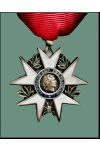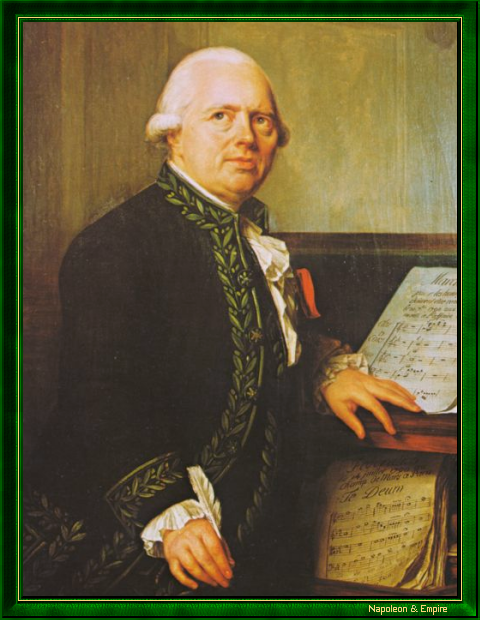François-Joseph Gossé, a.k.a. Gossec
Knight of the Legion of Honor
Pronunciation:

François-Joseph Gossé was the son of a farmer. He was born on January 17, 1734 in Vergnies, a French village in the Hainaut region, where he learned the rudiments of his future profession from the village priest.
He then joined the choir school in the capital Antwerp, where he continued his training.
In 1751, Gossec arrived in Paris. Jean-Philippe Rameau's patronage earned him the position of orchestra director for Monsieur de La Pouplinière, a farmer-general, which he held until 1762. He then moved on to work for the Prince de Conti (1762 or 1763) and the Prince de Condé.
After publishing trio sonatas as early as 1753, he produced duos, quartet symphonies and, from 1759, symphonies in which wind instruments were added to the strings. In 1760, he performed a Messe des morts for a cast of two hundred, which inspired Wolfgang Amadeus Mozart - with whom he maintained a close friendship - as well as Hector Berlioz. Gossec also tried his hand at comic opera (Le Tonnelier, 1765) and lyric tragedy (Sabinus, 1774), with little success.
In 1769, he founded the Concert des amateurs, in which the famous mulatto Saint-Georges played violin. From 1773 to 1777, Gossec was director of the Concert spirituel, introducing composers such as Johann Christian Bach and Joseph Haydn to Paris. In 1780, he was appointed deputy director of the Académie de Musique, then director of the École de Chant, the forerunner of the Conservatoire, four years later.
The French Revolution, which he supported as a Freemason, made him the official composer of patriotic celebrations. Among his many hymns, choruses and marches are Le chant du 14-Juillet, the hymns A l'Etre suprême and A l'humanité, and the Marche lugugubre, which may well have been one of the sources of inspiration for the funeral march in Ludwig van Beethoven's Symphonie héroïque.
During this period, Gossec successively became head of the national guard's music, a member of the Institut - in 1795 when the latter was reconstituted - and a founding member of the Conservatoire de musique. He taught composition there until the return of the Bourbons, from 1795 to 1814.
Napoleon awarded him the Légion d'honneur in 1804. Under the Empire, in 1809, Gossec composed a Symphony in 17 parts for the twentieth anniversary of the storming of the Bastille. It is not certain that it was performed during his lifetime. It was his last work in this form.
The Restoration held him in contempt for his revolutionary activism, and he fell into disgrace under Louis XVIII and Charles X.
Gossec died in Passy on February 16, 1829, aged nearly ninety-five. His tomb is in the 13th division of the Père-Lachaise cemetery , close to that of his friend Grétry.
"François-Joseph Gossé, dit Gossec" par Antoine Vestier (Avallon 1740 - Paris 1824).

His abundant output includes some fifty symphonies, most of them composed before 1789, making Gossec the most important French symphonist of the late 18th century. Almost forgotten today, they were nonetheless admired by Ludwig van Beethoven and Hector Berlioz.
Freemasonry: Gossec was initiated into the lodge La Réunion des Arts in 1751.